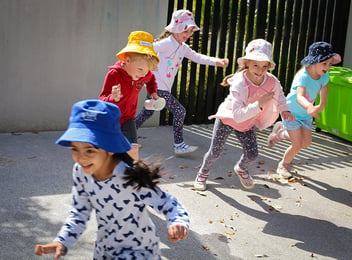ECMS’ Professional Development Day in 2025 was held during National Reconciliation Week. The theme for the week, "Bridging Now to Next," reflects the ongoing connection between past, present, and future, and underpins so much of ECMS’ place-based pedagogy. As our teams explored how each of us can contribute to achieving reconciliation in Australia, many were thinking about developing or strengthening their RAP.
What is a RAP?
ECMS Social Work Practice Coach Emma Carter came to us with a deep background in this subject. Emma’s previous Education Department-funded role with Cardinia Shire as Best Start Facilitator involved working closely with kindergartens to ensure they were culturally safe for First Nations people. This included helping in the development of a RAP, mindful that every service was in a different stage of their reconciliation journey:
“It was always done together. I would sit with them, alongside the Koorie Engagement Support Officer or the Aboriginal Best Start Facilitator. So we had those perspectives to then be able to identify different strategies they could implement as a part of their journey in learning about Aboriginal and Torres Strait Islander history, and how they could comfortably be able to embed that into the kindergarten setting.”
A RAP is a fantastic document to guide active reconciliation in a service, but often the best way to approach it is with small steps:
“You have to be ready to go on that journey. So it’s about meeting people where they are so that it's practical and meaningful. It’s about making the small changes that can accumulate to a greater change at the end.”
What are some of those small, practical ways our teams have been making a change?
-
Using Indigenous language keywords in everyday conversations
-
Creating meaningful acknowledgments of country that children can participate in
-
Designing cultural experiences connected to children's ideas
-
Incorporating Indigenous perspectives when discussing nature, such as talking about birds and their traditional lands
-
Displaying Indigenous artwork and resources in the classroom
-
Using literature and stories from First Nations authors and perspectives
-
Connecting curriculum experiences to significant Indigenous dates and events
-
Inviting local Indigenous community members to share stories and experiences
-
Creating curriculum experiences that explore Indigenous history and culture in age-appropriate ways
-
Making cultural learning a natural part of daily practice, not just a checkbox to be ticked
The key is to make these embeddings meaningful, authentic, and integrated into everyday learning, rather than treating them as isolated or tokenistic.
Based on her experience, Emma has a few ideas for services thinking about developing a RAP.
Create a RAP community
This isn’t just the educators, it can include the parent community, or whoever is in that local community that can help deliver the RAP, because it’s everyone's responsibility in that service environment. Reconciliation is also everyone’s business.
Draw on First Nations perspectives
Are there First Nations families in the community? It’s great to have that perspective to help you develop your RAP. That's not always possible, and that's okay too.
Call on your support systems
Find out about the support available to help you develop your RAP. These might include a Koorie Engagement Support Officer or Aboriginal Best Start Facilitator, who can give you practical advice on what to include in your plan. Local Aboriginal Community Controlled Organisations (ACCOs) and Land Councils are also great places for information.
Take the time that it needs
Once you’ve developed your RAP community, get together for regular meetings to guide what goes in the RAP and how it’s delivered. Then give yourself time to develop it. Emma recommends a year to develop, adopt and embed the RAP.
Assign responsibilities to make it come alive
A RAP is everyone’s responsibility. Once you’ve gone through the goals you’ve established, you need different people leading different areas to make sure that you can truly embed what you've put into the RAP.
Emma is a great resource, especially as she understands no two services will be the same in the way they approach their RAP:
“A meaningful decision to make is how it's going to be embedded into the service to reflect place-based practice. Every community is unique, and depending on who's in that community, there'll be different aspects of the RAP that will be included to represent that.”
And why is a RAP so important, and so much more than a box-ticking exercise?
“I think understanding history, being able to talk about it, being able to value culture, and being able to embed Indigenous perspectives as a part of our practice means that we've got the best opportunity to be able to create lifelong change for children and families.”
This way we are part of creating an Australia where all children have the opportunity to connect with Aboriginal and Torres Strait Islander knowledge systems, histories and cultures (Ngarrngga, 2023), a significant generational shift in how children learn about the place they call home, and that really matters to us


%20cropped-1.jpg?width=352&name=ECM_SHOOT1_LOWRES_@MAXROUX-1%20St%20Marys%200324%20(18)%20cropped-1.jpg)
